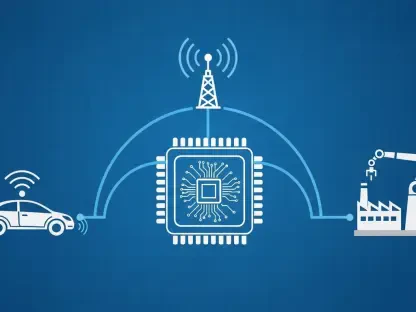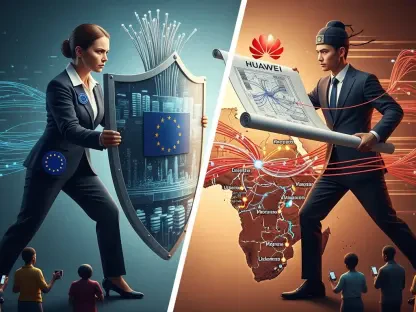The telecommunications landscape is on the brink of a monumental shift as the world anticipates the arrival of 6G, a technology poised to redefine connectivity with speeds and capabilities far beyond current standards, promising data transfers in the blink of an eye. Picture a scenario where real-time holographic communication spans continents or autonomous vehicles navigate complex urban environments with flawless precision. This transformative potential underscores the urgency for nations and industries to prepare for 6G, which promises to address the unmet aspirations of 5G while unlocking new frontiers in innovation. This review delves into the core aspects of 6G, exploring its technical foundations, recent developments, and the profound impact it could have on global economies and societies.
Introduction to 6G Wireless Technology
6G represents the next evolutionary step in wireless communication, building upon the infrastructure and lessons of 5G to achieve unparalleled performance. Unlike its predecessor, which focused on enhanced mobile broadband and low-latency applications, 6G aims to integrate intelligent systems and ultra-high-speed connectivity to support a hyper-connected world. Its vision includes enabling seamless interactions between billions of devices, from smart homes to industrial ecosystems, with data rates potentially reaching terabits per second.
The drive toward 6G is fueled by global technological competition, as nations recognize the strategic importance of leading in this domain. This technology is not merely an upgrade but a foundation for future innovations in areas like artificial intelligence and the Internet of Things. As research accelerates, understanding the scope and implications of 6G becomes essential for stakeholders across industries and governments.
This exploration situates 6G within a broader context of rapid digital transformation, highlighting its potential to bridge gaps in connectivity and empower emerging economies. The focus remains on how this technology can redefine communication paradigms while addressing the growing demand for sustainable and secure networks.
Key Technical Components of 6G
Advanced Spectrum Utilization
A cornerstone of 6G’s ambitious goals lies in effective spectrum allocation to meet its high-capacity and low-latency demands. Spectrum, the invisible backbone of wireless communication, must be available in contiguous bands to support the massive data throughput envisioned for 6G. Without adequate bandwidth, the promise of next-generation applications risks remaining unfulfilled.
Recent legislative strides, such as the passage of a significant bill restoring auction authority to the Federal Communications Commission (FCC), mark a critical step forward. This policy ensures collaboration with relevant agencies to identify and allocate spectrum for commercial use, creating a predictable pipeline essential for long-term planning. However, challenges persist in securing contiguous spectrum, especially as competing interests vie for limited resources.
The importance of spectrum availability extends beyond technical needs, influencing private sector investment in infrastructure and workforce development. A robust spectrum framework can catalyze innovation, positioning nations to capitalize on 6G’s economic benefits. Continued dialogue and policy adjustments are vital to overcoming existing bottlenecks in this area.
Intelligent Network Architectures
6G networks are expected to leverage artificial intelligence (AI) for dynamic management and optimization, a departure from traditional static systems. These intelligent architectures will enable self-healing networks capable of adapting to real-time demands, ensuring consistent performance even under peak loads. Such capabilities are crucial for supporting the massive connectivity required by future smart ecosystems.
The integration of AI also facilitates efficient resource allocation, allowing networks to prioritize critical applications like emergency services or industrial automation. This adaptability aims to minimize downtime and enhance user experiences across diverse scenarios, from urban centers to remote regions. The result is a more resilient and responsive communication framework.
Beyond technical efficiency, these architectures hold promise for reducing operational costs and energy consumption, aligning with global sustainability goals. As research progresses, the focus remains on refining AI algorithms to handle the complexity of 6G environments, ensuring scalability and security in equal measure.
Terahertz Frequency Bands
One of the most groundbreaking aspects of 6G is its potential use of terahertz frequency bands, which could unlock data rates far surpassing current capabilities. Operating at these ultra-high frequencies offers the bandwidth necessary for applications like immersive virtual reality and high-definition streaming on a massive scale. This leap forward, however, comes with significant technical hurdles.
Propagation challenges, such as limited range and susceptibility to environmental interference, complicate the deployment of terahertz bands. Overcoming these obstacles requires innovative solutions in antenna design and signal processing, areas where research is intensifying. The successful integration of these frequencies could redefine the limits of wireless communication.
The significance of terahertz technology lies in its capacity to support the exponential growth of data demand projected for the coming decade. While still in experimental stages, advancements in this domain are pivotal to realizing 6G’s full potential, making it a focal point for scientists and engineers worldwide.
Recent Developments and Policy Initiatives
The trajectory of 6G is being shaped by a flurry of policy efforts and technological advancements across the globe. A notable milestone is the recent legislation dubbed the “One Big Beautiful Bill,” which reinstated the FCC’s ability to auction spectrum, a move seen as foundational for 6G readiness. This policy also mandates partnerships to expand commercial spectrum access, fostering an environment conducive to innovation.
International coordination is another critical focus, with preparations underway for the World Radio Communications Conference in 2027. This event will play a decisive role in harmonizing global policies to achieve the scale necessary for 6G deployment. Early national strategies and allied coalitions are being formed to ensure interoperable and secure standards reflective of shared values.
Investment in research and development remains a priority, with governments and private entities channeling resources into exploratory projects. These initiatives aim to address technical gaps and position early movers for competitive advantage. The emphasis on collaboration underscores the recognition that 6G’s success hinges on unified global efforts rather than fragmented approaches.
Applications and Use Cases of 6G
6G holds transformative potential across multiple sectors, promising to deliver on applications that 5G could not fully realize. In education, immersive augmented reality could create interactive learning environments, allowing students to explore complex subjects through virtual simulations. Such advancements could democratize access to high-quality education on a global scale.
Transportation stands to benefit significantly, with autonomous systems relying on 6G’s ultra-low latency for real-time decision-making in dynamic conditions. From self-driving cars to drone delivery networks, the precision and reliability of 6G could revolutionize logistics and urban mobility. These use cases highlight the technology’s role in enhancing safety and efficiency.
Smart cities represent another frontier, where 6G’s capacity for real-time data integration can optimize infrastructure, energy usage, and public services. Imagine traffic systems adapting instantly to congestion or disaster response coordinated through a hyper-connected network. These possibilities underscore 6G’s potential to address pressing societal challenges through technological innovation.
Challenges and Limitations in 6G Deployment
Despite its promise, 6G faces substantial hurdles in implementation, starting with spectrum availability. Securing contiguous bandwidth remains a complex issue, with competing national and commercial interests creating potential roadblocks. Resolving these conflicts requires sustained policy innovation and cross-sector collaboration.
Technical challenges, particularly in deploying terahertz frequencies, pose additional barriers due to their limited range and sensitivity to obstacles. Developing infrastructure capable of supporting these bands demands significant investment and expertise, areas where progress is still nascent. Overcoming these limitations is essential to meeting 6G’s ambitious performance targets.
Geopolitical competition in standard-setting further complicates the landscape, as nations vie for influence in shaping global frameworks. Regulatory complexities and the risk of fragmented standards threaten to undermine economic viability. Addressing these issues through international dialogue and strategic alliances is critical to ensuring a cohesive path forward.
Future Outlook for 6G Technology
Looking ahead, the development of 6G is poised for potential breakthroughs that could redefine connectivity standards. Innovations in materials science and signal processing may unlock solutions to current technical constraints, paving the way for widespread adoption. The focus on experimental projects suggests that unexpected advancements could emerge in the near term.
Global harmonization will play a pivotal role in determining 6G’s economic and practical success. Aligning policies and standards across borders can prevent fragmentation, ensuring that industries benefit from economies of scale. Events like the upcoming international conferences will serve as key platforms for forging this consensus.
The long-term societal impact of a mature 6G ecosystem could be profound, reshaping industries, governance, and daily life. From enabling advanced telemedicine to supporting sustainable urban planning, the ripple effects of this technology may extend far beyond communication. Continuous investment and foresight will be necessary to harness these opportunities effectively.
Conclusion and Key Takeaways
Reflecting on the journey thus far, the exploration of 6G technology reveals a landscape brimming with potential yet fraught with challenges that demand attention. The technical intricacies, policy milestones, and visionary applications paint a picture of a transformative force that has yet to fully emerge. Each component, from spectrum utilization to intelligent networks, underscores the complexity of bringing this innovation to fruition.
Moving forward, actionable steps emerge as critical to sustaining momentum. Governments and industries need to prioritize sustained funding for research while fostering international partnerships to align standards. A concerted effort to address spectrum scarcity through innovative policies is deemed essential to avoid past pitfalls.
Beyond immediate actions, a broader consideration surfaces around nurturing a skilled workforce capable of navigating 6G’s demands. Educational initiatives and public-private collaborations are seen as vital to building this capacity. These strategies, if implemented with urgency, position stakeholders to not only adapt to but also shape the future of connectivity in a hyper-digital era.









